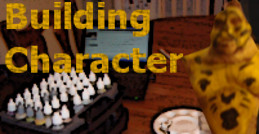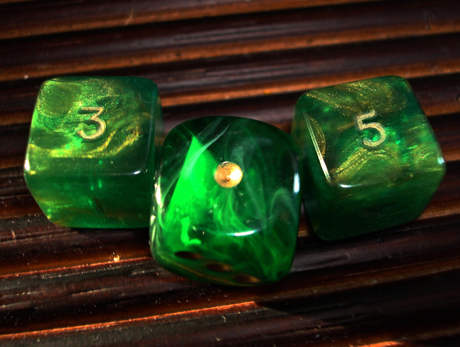A journal about a character’s creation and career. Ryan Costello starts at the ground floor of his latest character, Daitora, the sumo brawler.
Daitora has a miniature, he’s leveled to 2, and I have a few tricks in mind to use with martial maneuvers, the brawler’s elastic ability that grants him temporary access to combat feats. He was ready to roll. But was he ready to role?
I like to bring my characters to life at the game table. My rule is that if you can’t tell whether I am saying something in character or out of character, I have not separated myself from my character enough. And that’s important, because I play a lot of jerks. Portraying a character to me is a mix of:
• Voice: As in I do something to sound different, either an accent, an octave adjustment, or a distinct cadence;
• Attitude: The go-to emotion in which my character speaks. This is tricky because I want to set a default without creating a one-dimensional character;
• Trigger: The one topic they will react to differently than others;
• Catch Phrase: Either a battle cry or a topic they casually but constantly refer to.
But, as mentioned in a previous post, I don’t want any two characters of mine to play too similarly. My Kingmaker character Jeralyte and a 3.5 character of mine, the Scales of St Cuthbert, for example, are both through-the-roof conceited, but Jeralyte is passively condescending and brings up her heraldry often, whereas Scales was oblivious to the chip on his shoulder and talked about how great his god has made him. Small differences, and the rest of each character’s party reacted with a similar mix of annoyance, tolerance, and amusement, but the experience at the table for myself and the other players was different.
When crafting a personality, I pick one aspect or two aspects of a character’s build and either play that to the Nth degree, or play against stereotype. Jeralyte is almost entirely based on the Qadiran Princess trait, making her the most entitled, obnoxious princess type you can imagine, whereas Scales was an arcane caster who thought his powers were divine. Karkerkast was a low Charisma gnome, and so he became the anti-gnome, made more complex by his role as his village’s protector.
I have default assumptions about the different aspects of a character. For example, race:
Dwarf
• Voice: Deep, with a hint of Scottish;
• Attitude: Boisterous;
• Trigger: Ale makes them extremely sociable, combat makes them focused and fatalistic;
• Catch Phrase: “By my beard,” “ack!”
Elf
• Voice: Stoic;
• Attitude: Serious and dismissive;
• Trigger: Doing something impressive in their presence earns their respect;
• Catch Phrase: “Indeed?” “Must you?” “Well, that may be acceptable by [race] standards…”
Gnome
• Voice: Vaudevillian chatter mouth;
• Attitude: Playful;
• Trigger: If the topic turns to them, they put on false modesty;
• Catch Phrase: “I haven’t seen a [noun] that [adjective] since [long, convoluted example].”
Halfling
• Voice: High pitched but quiet;
• Attitude: Polite;
• Trigger: An instant flight response to any danger;
• Catch Phrase: “I don’t mean to alarm anyone, but…” “Not to be a bother, but…”
Half-Orc
• Voice: Clumsy, grumbly;
• Attitude: Defensive, inferiority complex;
• Trigger: Battle lets them release the innate anger they spend their other waking moments denying and repressing;
• Catch Phrase: “Or you can ignore my tusks and green skin and assume I’m not going to kill you,” “I’m sorry you don’t approve of my parents.”
Role:
Caster
• Attitude: Proud;
• Trigger: Any mention of their discipline gets them talking about its subtleties.
Healer
• Attitude: Passionate;
• Trigger: Failing to be useful makes them bottle up.
Skill Monkey
• Attitude: Cagey;
• Trigger: When their skills can be put to use, they dismiss any other suggestions or offers for help.
Warrior
• Attitude: All business;
• Trigger: Social situations make them uncomfortable, puzzles frustrate them, most things that can’t be solved with a sword garner their ire.
The same can be done for each class, each alignment, and high and low versions of each ability score. What’s important to emphasize is that even though I am calling these defaults, they are not automatic. These defaults evolved from GMing, when I might suddenly need to establish that an elf character is a fighter without blatantly saying as much. For my PCs, and my important NPCs, switching or maximizing these assumptions lets them stand out. Going back to Karkerkast, he wouldn’t have been nearly as memorable had he been a surly, foul-mouthed dwarf. That he played as the opposite of every other gnome in our campaign world made him fun.
There is one more factor that contributes to my character: theme. This is especially true of humans, who you may have noticed weren’t summarized above. That’s because, just like their mechanics are all flexible, there is no default human. It’s what makes them human. Like the medium player in Nintendo’s Ice Hockey. No, not like the medium player in Nintendo’s Ice Hockey. Ignore that example.

This isn’t exclusive to humans, of course. I had no idea how to play my teifling staff magus Jaymon for years (back when I only played him a couple of times a year) until I decided that, like his weapon of choice, he would be blunt. Valter, my lore warden /inquisitor of Calistria is mostly defined by how remarkably neutral he is to having killed his entire family after they succumbed to a mutating madness.
And so, Daitora. He’s a human brawler, specifically a sumo, with an affinity for tigers. He’s a chaotic good Shoanti, and a member of the Grand Lodge faction.
The early, obvious aspect to focus on would be go sumo and go sumo big. Bad generic Asian accent, a person of tradition and confidence, discipline.
All Sumo
• Voice: Ambiguous Asian accent;
• Attitude: Measured;
• Trigger: Proud of his weight, and especially enjoys using it to crush those who would mock him for it;
• Catch Phrase: Nonverbal sumo posturing, with a lot of stomps and squats.
I think the problem here is that it’s too obvious. Plus it contradicts with the chaotic alignment and the Shoanti ethnicity, both of which I went with specifically to add depth to the concept. I’m having trouble with going halfway sumo. It might have to be all or nothing, and if that’s the case, all sumo seems dull.
What about going tiger? When I think of a tiger’s personality, I can’t shake Shere Khan from Disney’s Talespin.

For the uninformed, in the 90s, Disney adapted some of its movie properties to action cartoon series. Adapted, in this case, means taking a few proper names, voices, and character designs and applying them to an otherwise completely unrelated idea. It’s how Chip ‘n Dale went from rascally rivals of Donald Duck and each other to Indiana Jones and Magnum P.I. teaming up as the Rescue Rangers, and it’s how the cast of the Jungle Book (without the film’s cautious conscience, Bagheera the panther, or the protagonist Mowgli) became mixed up in an adventure involving export by seaplane and fighting seapilots. Even without the Jungle Book connection, Talespin combined a bizarre setting with odd themes to create a strange kid’s cartoon. The Jungle Book connection just turned all that weirdness on its head.
Which brings us to Shere Khan. In The Jungle Book, he’s the bully of the jungle, with a prejudice against humans that puts him at odds with Mowgli. In Talespin, Shere Khan is a Lex Luthor-like super villain whose powers are business savvy and lack of scruples.
Shere Khan
• Voice: Well-spoken without being verbose;
• Attitude: Conniving.
• Trigger: Afraid of fire, hesitates before spending money;
• Catch Phrase: “Well now…”, “And what is in it for me?”
Basing a sumo hero on Lex-Luthor-as-tiger has a similar appeal as Talespin; it’s so close to an obvious disaster that no one has ever tried it before. And I don’t know if anyone ever will. Although I am almost sold on it as another excuse for Daitora foregoing armour (when spend money on armour when somewhere a cleric will heal you for free), I hesitate. We’ll see.
From the obvious to the obscure, my third concept is less known than Talespin. It’s based on a meme from a GI Joe message board. In 2000, Hasbro released a collector’s series of GI Joes, a mix of big names (Cobra Commander, Snake Eyes) and second fiddles (Law, Range-Viper) mostly based on what molds were available and catalogue correctly in their Chinese warehouses. There were problems with this series. For example, of the eight original characters released, one was named Sidetrack and one was named Side Track. These were two separate characters. Hasbro had lost the rights to the name Roadblock so they released a Roadblock knock-off named Double Blast, the first in a long line of poor roadblock substitutes. But no character from that era lived in infamy among GI Joe fans as much as Big Brawler.
First of all, terrible name, but that is not new in GI Joe. Second, he resembles fashion designer Chris Lowell. Third, his file card was an over-the-top Mary Sueism that made him, simultaneously, a master of psychological warfare and hand-to-hand combat, he has the natural ability to persevere in jungles in ways that Tarzan would be jealous, he refused officer-level promotions. GI Joe filecards may not be high art, but generally they show a character’s human side. Instead, Big Brawler was corner-to-corner awesomeness. He breathed awesome, he ate awesome, and he defecated awesome. Joecustoms.com started referring to anything remotely awesome as “brawlin’”, and took Big Brawler as a mascot, turning his ridiculousness into a site-wide in-joke. The joke kept going because, for whatever reason, Hasbro continued to release new Big Brawler action figures. It was like they were in on Joecustoms’ joke. In fact, every Big Brawler released after v1 was in Tiger Force colours.
Big Brawler may be a rediculous GI Joe worthy of mockery, but the sarcastic version of the character that emerged on Joecustoms.com makes a great PFS character, and a sumo to boot. He’s big. Everything he does is big. Everything he says is big. Daitora, the Big Tiger brawler, won’t just get the job done, he’ll smash in any chumps that get in his way, because his fists are like hammers, monsters’ faces are anvils, and he’s fixing to forge massacres. Throw in some sumo aspects and we have:
Daitora
• Voice: Loud and fast;
• Attitude: Unbridled enthusiasm;
• Trigger: Proud of his weight, and especially enjoys using it to crush those who would mock him for it;
• Catch Phrase: “Brawlin’” with lots of sumo posturing.
I like it. The pressure will be on to fit more exclamation marks into each session, and I am up for the challenge. Daitora is ready to brawl!






Leave a Reply